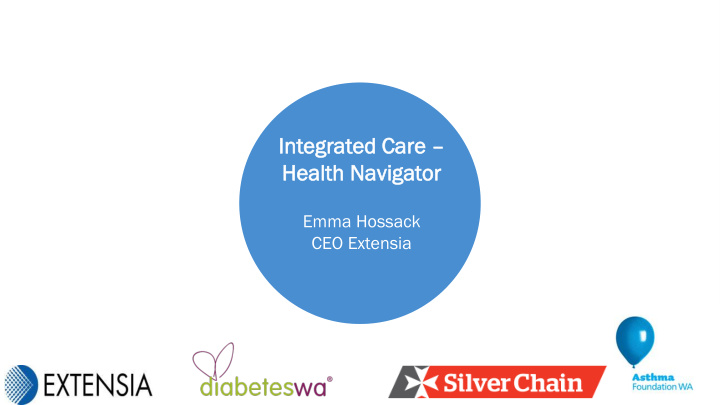



In Integrated tegrated Ca Care re – Hea Healt lth h Nav avigator gator Clean Emma Hossack CEO Extensia
Sou Southern thern Inl Inland Health and Health Init Initiativ iative e - SIH SIHI
Project Area Pro ject Area People Living in Country WA Experience • higher rates of diabetes, cardiovascular and chronic obstructive pulmonary disease • admissions to hospital and/or presentation to emergency care due to chronic conditions • a lot of preventable admissions - In 2010 the estimated cost of potentially preventable hospitalisations to WACHS was $89 million, of which $55 million is related to chronic conditions. • a 2 year shorter life expectancy than metropolitan areas WA Country Health Service Serves: • a population of almost 560,000 people, (21 per cent of WA’s total population) dispersed over a vast geographic area covering 2.55 million square kilometres – more than 10 times the size of the United Kingdom • a larger than usual indigenous population - In metropolitan Perth 1.6 per cent of the population is Aboriginal (33,000 people) and in country WA this increases to 7.6 per cent (42,500 people). . •
Purpose Purp ose • To enable aged people suffering health issues to stay at home longer and avoid preventable hospitalisation • To use tools shared with many levels of providers - modified as required • To use telehealth and video conferencing through a Health Navigator service – linking sufferers of Chronic respiratory conditions or diabetes with the right level of care. • To measure the effect of intervention in systems
Any Good? • What say the users? The consumer provider interviews indicate great enthusiasm. Comments such as “it has changed my life” are rare in digital health programmes: Health Navigator – Diabetes management - https://youtu.be/CuUgIxrkXyM Health Navigator – Heart and lung disease management -https://youtu.be/TzcmhT-Za-I • How often do they share? 75% of the CISS records are accessed by 2+providers in the last 12 months & 38% are accessed by 4+ providers - strong indicator of actual sharing. 1200 referrals pcm, • Who uses it? 700 healthcare providers including half the GPs in the area. The Lions Van, Diabetes WA and Asthma WA – no limit to number of NGOs which can join • Trusted? Yes. A year of education followed the Scottish model for OPT OUT. For an entertaining link on OPT OUT see how Google does it https://m.youtube.com/watch?v=lMChO0qNbkY • Measurement? Real time reporting and notifications enable swift remedial action. Daily reports to monitor usage and graphical statistics – measures real purpose of shared record, not just registrants.
Brick Bats • Provider attitude to sharing. • Initial difficulty matching the consent model with the cohort. • Lots of systems being bundled up at the time in wheatbelt – providers overwhelmed. • Indigenous population in Southwest very displaced – history of Yorke, stolen generation etc. • Uncertainty with change of government and funding. Ross Bonifanti sculpture Courtesy Rebecca Hossack Gallery London
Bouquets • Within Budget and time – it works • Consumer and provider satisfaction • Team enthusiasm • Taken up without incentives • Grew organically without unrealistic political milestones – DWA, AF and EV • Appreciation of the need to accept and do something about feedback – the consent model name & templates Courtesy Rebecca Hossack Gallery,Hepzibah Swinford
Emm Emma a Hoss Hossack ack • CEO Extensia • President Medical Software Industry Association • Treasurer International Association of Privacy Professionals ANZ • Director ScriptWise • Contact: ehossack@extensia.com.au; +61 411478799
Recommend
More recommend